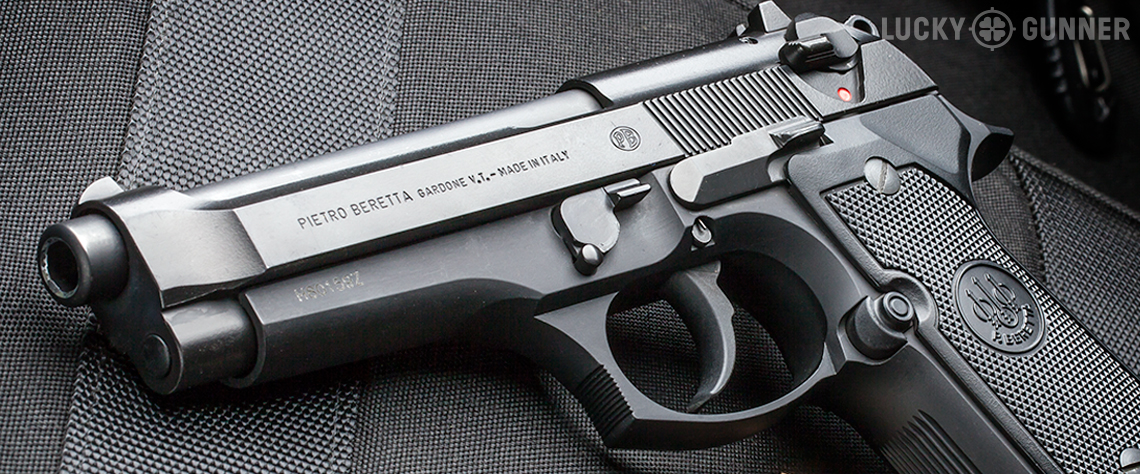During the course of our series on double action semi-autos, I mentioned a couple of times that I’m a fan of the Beretta 92 pistols, and it’s one of the guns I’ve been spending a lot of time with at the range this year. But this gun isn’t just a personal favorite — it’s one of the most ubiquitous full-size self-defense handguns in the country. Entire books have been written about the 92, and it’s been the topic of much debate in the shooting world. Despite this, however, I’ve found that there are a lot of misconceptions about the Beretta 92 that seem to pop up again and again. So I’m devoting this week on the blog to a brief study of this old workhorse to hopefully clear up some of the confusion.
To kick-off this mini-series, I thought I’d give a brief history of how the Beretta 92 has changed over the years. A lot of people are only aware of the 92FS version, and many of the criticisms and complaints about the 92 revolve around this particular model. While the 92FS is the most common variant, there were several 92 models that preceded its introduction in 1985, and countless variants have been produced since, including several that have directly addressed some of the more common gripes folks had with the 92FS. Mentally keeping track of all of the present and past 92 models is nigh impossible, so we’ve created this handy chart that includes the most common models (and a couple of those that aren’t so common).
Beretta 92: The Beginning
The Beretta 92 series has been in continuous production in one form or another since 1976, but its popularity in the US really began in 1985 when the 92F was officially adopted by our armed forces as the M9. During that first decade of its existence, the Beretta 92 underwent many critical changes to its design before it eventually became the iconic 92FS that we’re so familiar with today.
The Beretta Model 92 was originally designed using various elements of previous Beretta pistols along with heavy influence from the Walther P38. This first Model 92 is recognizable as part of the 92 family but just barely. In place of the slide-mounted safety/decocking lever that has become one of the trademarks of the series, it had a frame-mounted safety similar in appearance to the thumb safety found on the M1911. This feature didn’t last for long, however, and the second iteration of the 92 series — the 92S — debuted with a slide-mounted safety lever.
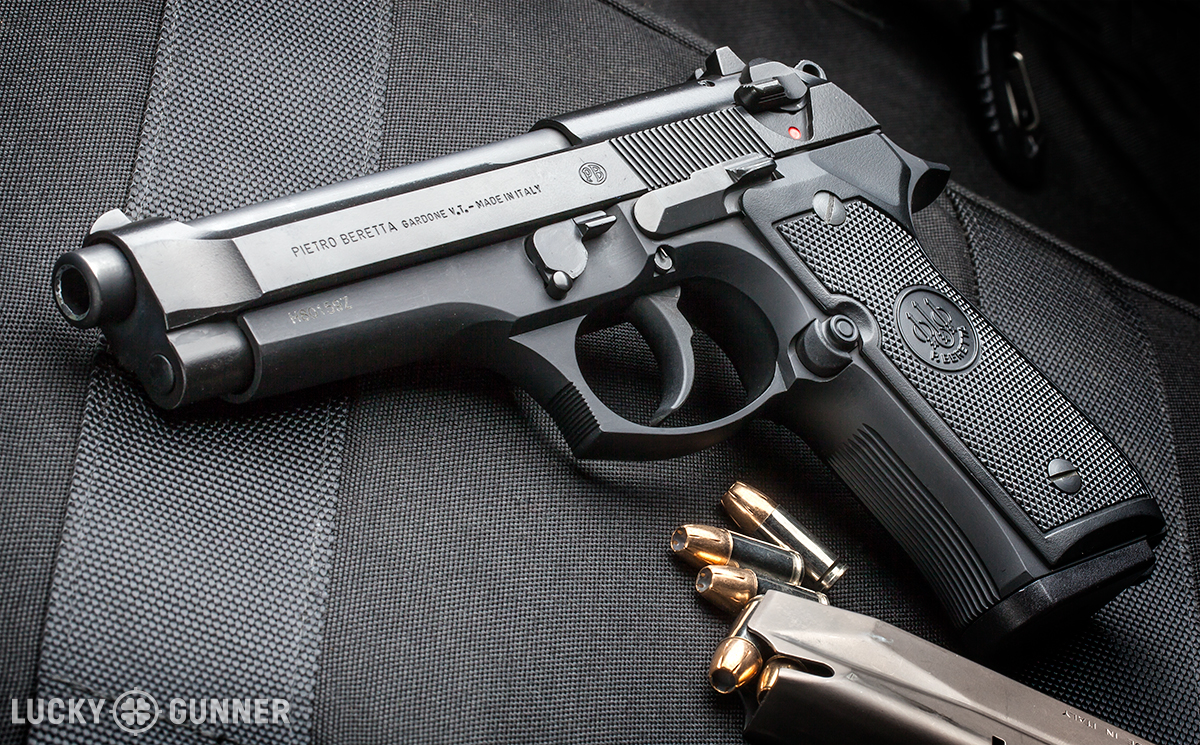
Another conspicuous attribute of the first Model 92 was the heel-mounted magazine catch, which was common among European-designed pistols of that era, instead of a thumb-activated magazine release button. This feature was retained on the 92S, but after the US armed forces expressed interest in the 92S, Beretta changed the layout of the pistol’s controls. The following model 92SB went into production with the mag release moved to its more accessible location behind the trigger guard.
As the US military’s sidearm selection process lumbered forward from the late 1970s into the mid-80s, feedback from military personnel led to many other small changes in the 92’s design. A slight forward flare was added to the contour of the grip front strap. The traditional blued finish was changed to the more utilitarian matte black Bruniton finish. White dots were added to the sights and the shape of the trigger guard was changed from a rounded profile to a more squared design. The result was the 92F, dubbed the “M9” by the US armed forces. It quickly became a popular choice in American law enforcement and on the commercial market. Shortly after introducing the 92F, Beretta released the updated 92FS, which included a minor internal safety improvement.
Those G D Berettas
During the 1990s and early 2000s, Beretta rolled out dozens of limited-production variants of the 92FS with interesting features that would eventually find their way into major updates of the design. Many of these features were added as the result of special requests from law enforcement contracts while others were influenced by target and action pistol competitors.
The 92G and 92D were among the more popular law enforcement variants. The French national police, or Gendarmerie, requested a version of the 92FS with no manual safety. Beretta offered the 92G, which is identical to the 92FS except the slide-mounted safety lever functions only as a decocker. For many years, the 92G was only available as a special order option for government contracts but, eventually, Beretta would begin to produce limited runs of 92G variants for the commercial market.

The 92D was a similar story. As law enforcement personnel across the country transitioned from carrying double action revolvers to semi-automatic pistols, some of their leaders were looking for ways to make that transition as pain-free as possible. The Beretta 92D has no safety/decocking lever at all and, instead, relies on a double action only trigger for safety, which is what most cops at the time were already accustomed to. The 92D was never much of a success commercially, but it has made a lasting impression in the development of the 92 series thanks to the lighter hammer spring Beretta used in these pistols. A popular modification made by 92 series owners (and also found in some factory models) is to replace the standard hammer spring used in F and G models with the lighter “D spring” in order to slightly reduce the weight of the double action trigger pull.
Following another trend in law enforcement, in the early 90s, Beretta began offering a version of the 92 chambered in .40 S&W called the Model 96. Since then, the majority of 92 variants produced have also been made available as a 96 option, sold both to cops and commercially to non-uniformed citizens. Early versions of the 96 were known to wear out quickly, but Beretta later strengthened the frame of all 92 and 96 pistols in places where the high pressure of the .40 S&W cartridge was causing problems.
Among the more popular 92 variants over the years have been the “Inox” models. Taken from the French word “inoxidable”, Inox Berettas have a stainless steel slide and barrel. The frame is anodized with a dye to match the silver appearance of the slide. Like the 96, most 92 variants have been offered with Inox as an option at one time or another.
Size Variants
One of the very first variants of the 92 series ever offered was the 92SB Compact L, which came along in the very early 1980s. It was essentially the same as the 92SB with the barrel shortened from 4.9 to 4.25 inches and the length of the grip reduced, which lowered the magazine capacity from 15 rounds to 13 (full-size Beretta 92 magazines may be used, though they will protrude from the grip slightly). Eventually, the 92SB Compact L was replaced by a compact version of the 92F and then the 92FS in 1990. The 92FS Compact L has been in Beretta’s catalog on and off ever since. In 2011, Beretta introduced the latest compact model based on the M9A1, featuring an accessory rail and aggressive grip texture. All of these compact models followed the same pattern as the original 92SB, using the same barrel length and magazines.
In the late 80s through 2004, Beretta also offered the Compact L Type M variant. Viewed in profile, the Type M appears to be identical to the standard Compact L, but closer inspection will reveal a slightly narrower grip to accommodate a single stack 8-round magazine. For a very brief period in the early 2000s, Beretta produced limited-run special edition compact models called the Custom Carry (a 92 FS Compact L with a single-sided safety lever) and the Custom Carry II (a 92FS Type M Inox with a single-sided safety lever and Novak rear sight). For the first half of this year, Wilson Combat offered the Beretta 92G Compact Carry with a target crown barrel and Wilson Combat grips and rear sight.
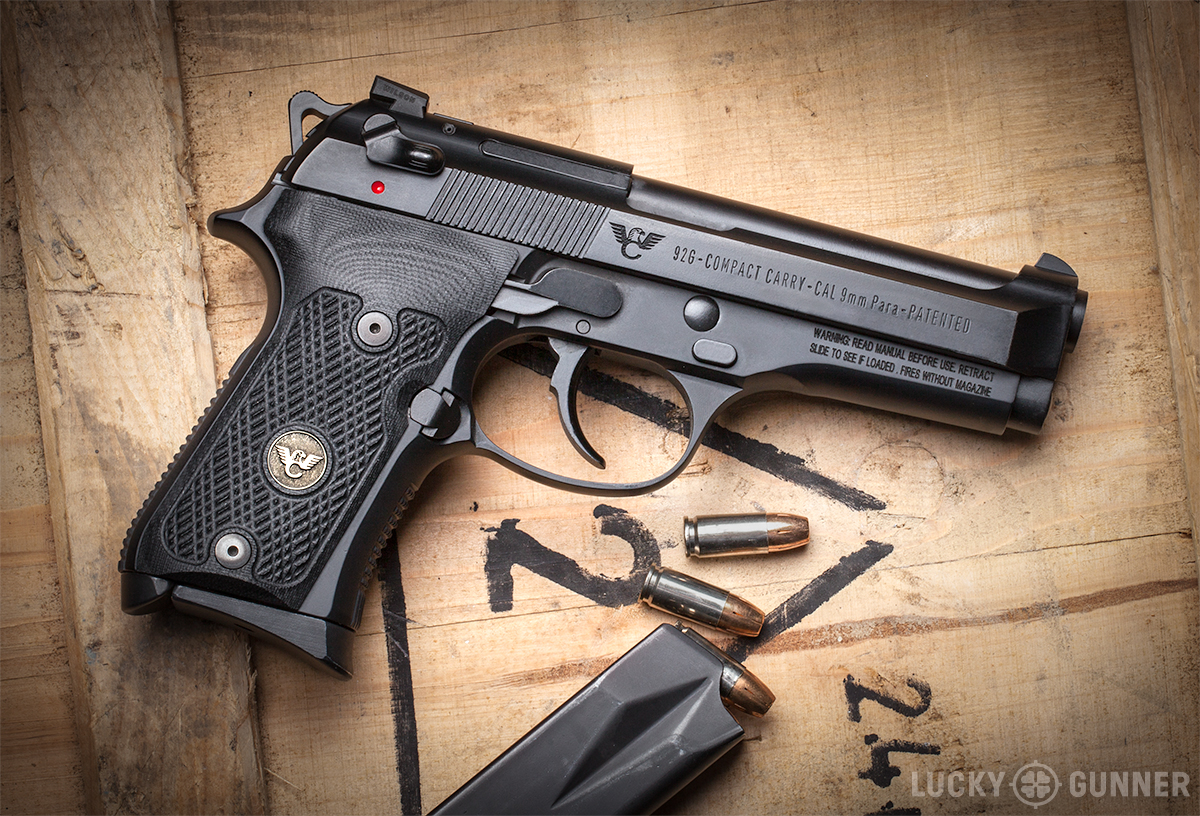
When you start with a larger-than-average full-size pistol, it’s no surprise that the compact version also ends up being a bit large compared to its counterparts from other manufacturers. The 4.25-inch barrel of the 92 Compacts is closer to the length of most full-size pistols than it is to other popular mid-size compacts like the Glock 19 and Sig P229. The butt of the 92 Compacts is roughly the same length as other compact models, but the ammo capacity is only 13 rounds of 9mm, compared to the 15 rounds you’ll usually get from other guns. This disparity in size and ammo capacity has prevented the 92 Compact from being a popular option among today’s concealed carry pistols, but fans of the full size 92 often find that the Compact L offers just enough reduction in size to make the 92 manageable for concealed carry while still retaining most of the larger gun’s shootability.
One final size variant of the 92 that’s often overlooked is the now-discontinued Centurion. With a full-size Beretta 92 frame and a compact slide and barrel, the Centurion has often been considered analogous to the Colt Commander 1911. Several versions of the 92 and 96 Centurion were produced beginning in the early 1990s, but Beretta discontinued all of these models when 92 series offerings were trimmed back in 2004. However, in recent years, Beretta has made a return to serving some of the more niche interests among 92 fans, and I wouldn’t be surprised to see a Centurion variant offered again at some point in the near future. In the meantime, some Beretta owners may be tempted to create their own “Centurion” by mating their 92 Compact slide to a full size 92 frame, but Beretta does not recommend it. The parts might fit together, and the combo may even function for a while, but the pistol will experience increased wear and less reliable feeding.
Brigadier, Vertec, and Beyond
In 1993, Beretta introduced the Brigadier style slide for the 92 series. This slide is reinforced at the locking lugs for greater durability, creating a trademark “hump” in the slide’s contour when viewed from the side. One of the first users of this style slide was the US Border Patrol, who ordered the Brigadier version of the 96D in the hopes that the pistol would better hold up to the hot .40 S&W duty loads they issued at the time. With other improvements now made standard on the frames of all 92 and 96 pistols, it’s debatable whether the Brigadier slide actually improves the gun’s longevity. However, many users have noticed that the Brigadier slide provides the unintended benefit of reducing felt recoil and muzzle rise. As a result, the Brigadier design has been used in many 92 variants designed with high-performance action pistol competition in mind.
In the early 2000s, as Beretta struggled to compete with other manufacturers in the crowded law enforcement market, one of their major efforts was the 92 Vertec. Among other things, the Vertec attempted to address the common criticism that the 92 series is difficult to use for shooters with smaller hands. With a short reach trigger and a drastically reduced backstrap, the Vertec model was a radical deviation from previous 92 models ergonomically speaking. The Vertec also modernized the 92 design by including an accessory rail on the frame, a beveled magazine well to accommodate quick reloads, and a dovetail cut in the front of the slide to allow the use of different aftermarket front sights. Additionally, the barrel was shortened from 4.9 inches to 4.7 inches while retaining the same slide length as the standard 92FS, thereby eliminating the barrel protrusion that had always been a visual trademark of the 92 series. While the Vertec grip design has some fans, it’s never been the most popular modification to the 92 series. That said, the accessory rail, replaceable front sight, and flared magazine were welcome changes that have been utilized in many other models.
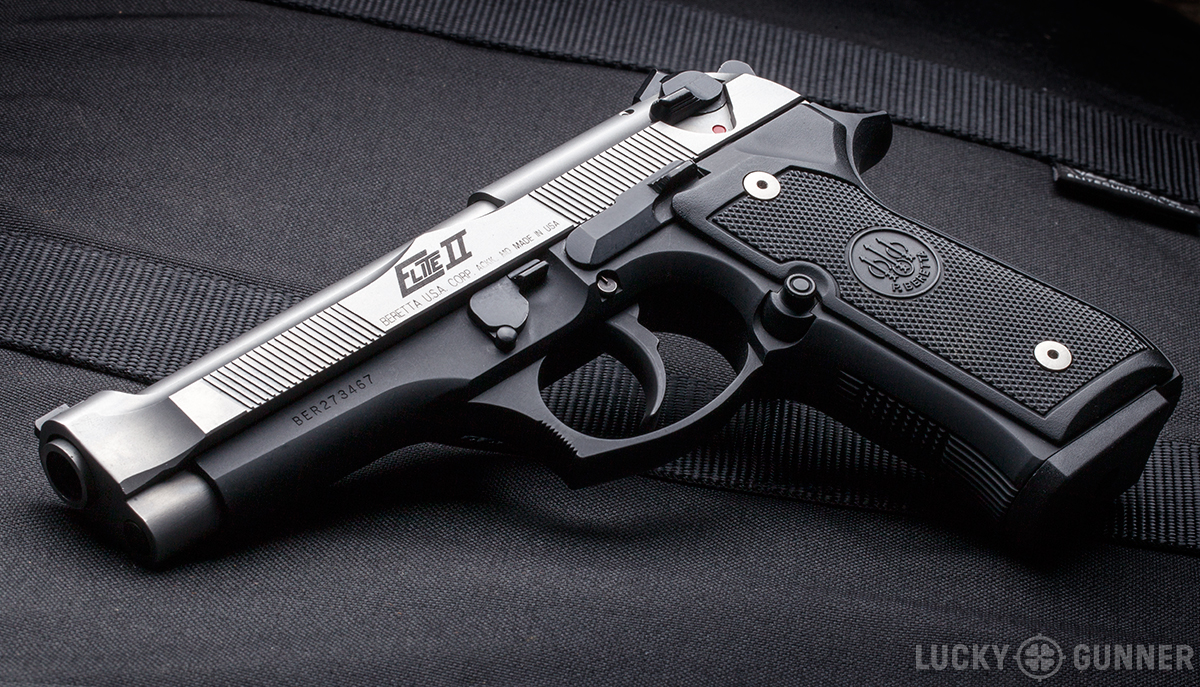
In fact, since the turn of the century, most new editions of the 92 series have essentially mixed and matched various features originally found on the Vertec and Brigadier. The competition-oriented 92G Elite combined the Brigadier slide with replaceable front sights, 4.7-inch barrel, and beveled magazine well. The Elite IA was similar but utilized the Vertec’s straight backstrap grip design and railed frame. The Elite II was a near copy of the original Elite but used Novak rear sights, a target crown barrel, and introduced a frame with aggressive grip texture. The popular 92G-SD was the first to combine a railed frame with the standard 92 grip contour, beveled mag well, and aggressive grip texture from the Elite II. With a production period of just a few years in the mid-2000s, the 92G-SD would become a sought-after fan favorite and would go on to influence the design of future 92 variants.
Around the same period, the US military requested some changes to the original M9 design. Beretta answered with the M9A1 which borrows features from the 92G-SD’s frame, leaving the slide of the original M9 largely unchanged. In 2010, Beretta released an updated commercial version of the 92FS, somewhat confusingly called the 92A1. It includes a railed frame but, unlike the M9A1, uses the standard grip serrations of the original 92FS. The 92A1 has a replaceable front sight along with some internal slide design changes that were originally used on the 90Two, an odd 92 variant with a drastically restyled external appearance.
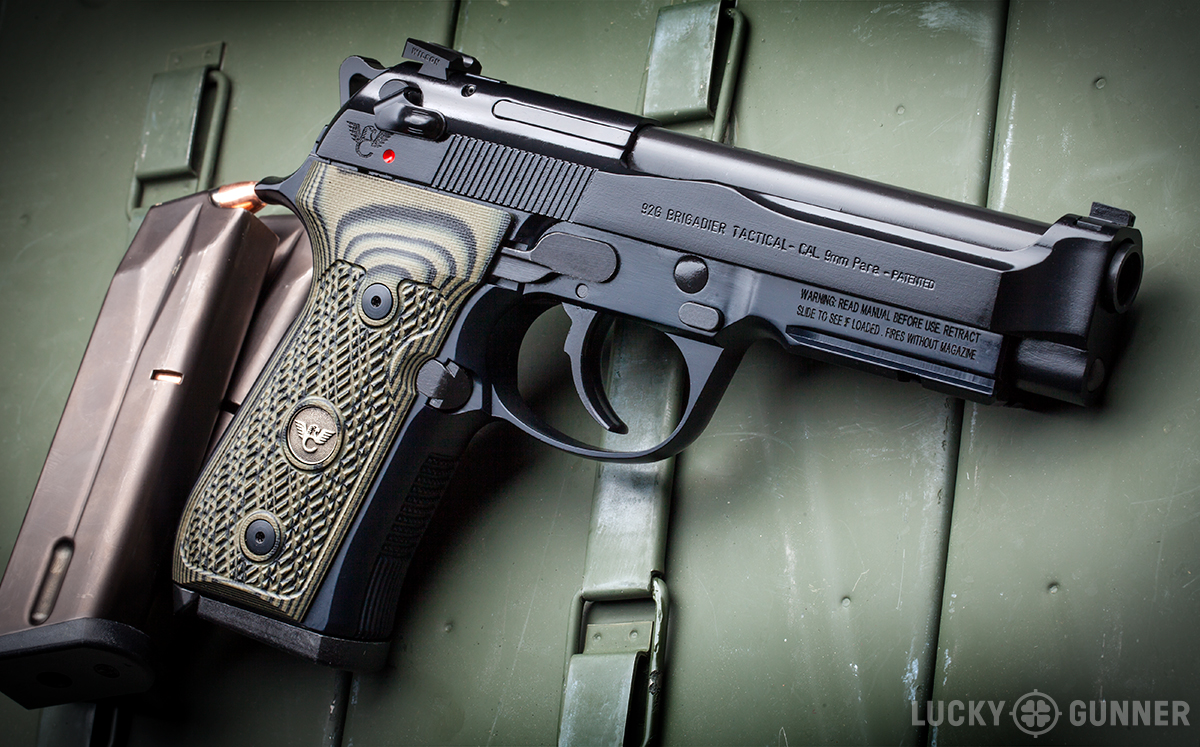
For 92 fans looking for that “holy grail” pistol combining the best of all of the above features, Beretta and Wilson Combat joined forces to offer the 92G Brigadier Tactical in 2014. This pistol is heavily based on the 92G-SD, but also includes, among other things, a rounded trigger guard, 4.7-inch barrel (which some shooters believe offers better accuracy than the standard 4.9-inch barrel), a Trijicon replaceable front sight, Wilson Combat rear sight, and VZ grips.
The latest update to the 92 series is the M9A3, and it may be the most feature-rich 92 model yet. First unveiled at SHOT Show in 2015, the M9A3 has a replaceable front sight, railed frame, and a Vertec style backstrap combined with aggressive grip texture. The pistol also includes a wraparound style rubber grip to mimic the feel of the standard M9A1 backstrap. The truly innovative feature of the M9A3 is a redesigned slide that allows the pistol to be converted between an FS and G configuration by an armorer with a conversion kit. Previously, this kind of conversion could only be performed by a gunsmith which is both expensive and permanent.
Even after 40 years of evolution and innovation, it’s clear that we haven’t seen the last changes to the 92 series, and we probably won’t for many years to come.
